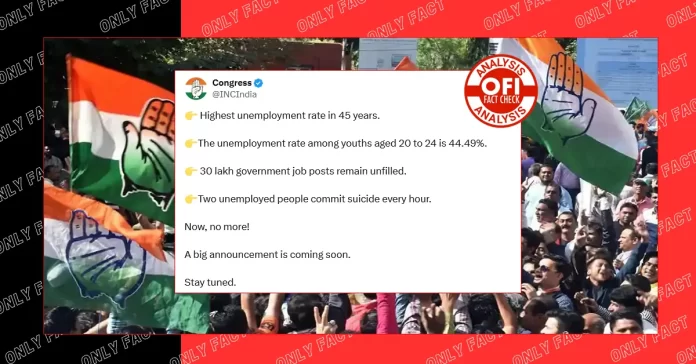As the impending general elections are on the horizon, the political landscape of India finds itself embroiled in a fervent clash of narratives. On one front stands the incumbent ruling party, touting a decade-long legacy of achievements, from bolstering India’s global standing to propelling its GDP into the echelons of the top five, all while safeguarding the nation’s quintessential ethos – its Sanatan culture. Conversely, the opposition, under the banner of the INDI alliance, has unfurled the banner of unemployment, often entwined with a purportedly anti-Sanatani ideology.
👉 Highest unemployment rate in 45 years.
— Congress (@INCIndia) March 6, 2024
👉The unemployment rate among youths aged 20 to 24 is 44.49%.
👉 30 lakh government job posts remain unfilled.
👉Two unemployed people commit suicide every hour.
Now, no more!
A big announcement is coming soon.
Stay tuned.
Youth in the Indian workforce dropped from 25% in 2016-17 to 17% in 2022-23, while vacancies in the Central govt have crossed 9.6 lakh, as of last year.
— Congress (@INCIndia) January 12, 2024
On National Youth Day, we pledge to tackle unemployment & give wings to the millions of aspirations that shape our tomorrow. pic.twitter.com/RuDssRqkJf
VIDEO | Here’s what Delhi Minister and AAP leader Atishi (@AtishiAAP) said on BJP’s manifesto during a press conference.
— Press Trust of India (@PTI_News) April 14, 2024
“Youths are worried because of unemployment, the price of (LPG) cylinders has risen from Rs 300 to Rs 1200, diesel price has risen from Rs 55 to Rs 90. Every… pic.twitter.com/8E4216L382
#WATCH | Patna: RJD leader Tejashwi Yadav says "From 15th August, people will start getting freedom from unemployment. If our Govt comes to power, the process of providing jobs will start from 15th August. On the occasion of Raksha Bandhan, we will provide Rs 1 lakh to our… pic.twitter.com/wri9LADWtM
— ANI (@ANI) April 13, 2024
In the following discourse, we embark on an exploration of the vexing topic of unemployment, aiming to uncover the genuine data obscured amidst a deluge of purportedly skewed information propagated by various Western and some domestic agencies. Our examination extends beyond national boundaries to scrutinize global employment trends, unraveling the evolving nature of job markets and the challenges faced by today’s youth, coupled with a call to action urging them to align their skills with the dynamic demands of the workforce.
1- GDP Growth and employment goes hand-in-hand
The focal point of discussion lies in understanding the intricacies of the unemployment rate and its calculation. Defined as the percentage of individuals without employment, this metric fluctuates in tandem with prevailing economic conditions. During downturns, job scarcity leads to an uptick in unemployment, while a thriving economy with ample job opportunities sees a decline in this rate.
The unemployment rate formula, expressed as the ratio of unemployed individuals to the civilian labor force, elucidates key components. To be categorized as unemployed, one must be at least 16 years old, available for full-time work in the past four weeks, and actively seeking employment. Exceptions include those temporarily laid off and seeking reemployment.
India serves as a pertinent case study, boasting a robust 7.5-8 percent annual GDP growth and poised to breach the 4 trillion mark, with sights set on reaching five crore. Such impressive figures underscore the correlation between economic prosperity and employment rates. A burgeoning GDP signifies increased production of goods and services, indicative of heightened demand and, consequently, a workforce expansion.
Consider a hypothetical scenario: Company A, producing 100 units of biscuits with 10 laborers in 2024, experiences a 10 percent surge in demand, necessitating production of 110 units. This uptick in demand mandates the hiring of an additional worker to meet production needs, underscoring the symbiotic relationship between economic growth and employment.
India’s projected 8 percent growth rate until 2047 portends a commensurate expansion in employment opportunities. It’s a trajectory where economic strides precipitate workforce augmentation, reflecting the inexorable link between GDP growth and employment prospects.

2- The ‘Real’ Data Shows Growth in Employment Numbers
A report commissioned by the Directorate General of Employment underscores the crucial role of the Periodic Labour Force Survey (PLFS) as the primary data source for gauging employment and unemployment dynamics in India since 2017-18. Prior to this, the National Statistical Office (NSO) conducted quinquennial surveys on the same.
The PLFS data reveals a gradual decline in the unemployment rate over the past few years, from 6.0% in 2017-18 to 4.2% in 2020-21. However, the COVID-19 pandemic disrupted this trend, particularly impacting the urban labor market, with the unemployment rate soaring to 20.8% in the first quarter of 2020-21. Nonetheless, subsequent quarters witnessed a remarkable recovery, with the unemployment rate dropping to 8.2% in the last quarter of 2021-22.
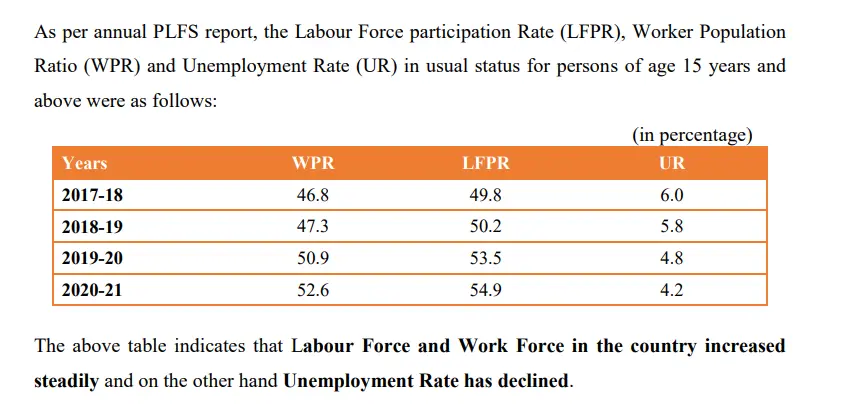
The Ministry of Labour’s Employment-Unemployment Survey (EUS) supplements these findings, providing comprehensive labor force statistics across various sectors. According to the EUS, the unemployment rate decreased to 7.6% in March 2024, indicating a positive trend. Similarly, data from the Consumer Pyramids Household Survey by the Centre for Monitoring Indian Economy (CMIE) corroborates this decline, reporting a decrease in the unemployment rate from 8% in February 2024 to 7.6% in March 2024.
Moreover, the Department of Economic Affairs highlights a significant improvement in India’s employable youth, with the percentage rising from 33.9% in 2014 to 51.3% in 2024. Focused efforts in mass skilling since 2014 attributed to this surge, evidenced by India’s enhanced performance in WorldSkills Competitions and the uptick in higher education enrollment.

Overall, these reports paint a picture of resilience and progress in India’s employment landscape, underscored by concerted efforts in skill development and education, culminating in an expanding and increasingly employable workforce.
3- Arvind Kejriwal and Uddhav Thackeray are Allegedly Responsible for Workforce Disruptions.
While it may seem like a far-fetched blame game against opposition leaders, reports suggest that there may be some truth to the allegations. According to the Directorate General of Employment report, the unemployment rate plummeted to a mere 4.2 percent in 2020-21. However, this commendable progress was marred by the impact of the COVID-19 pandemic, exacerbated by the actions of Arvind Kejriwal and Uddhav Thackeray.
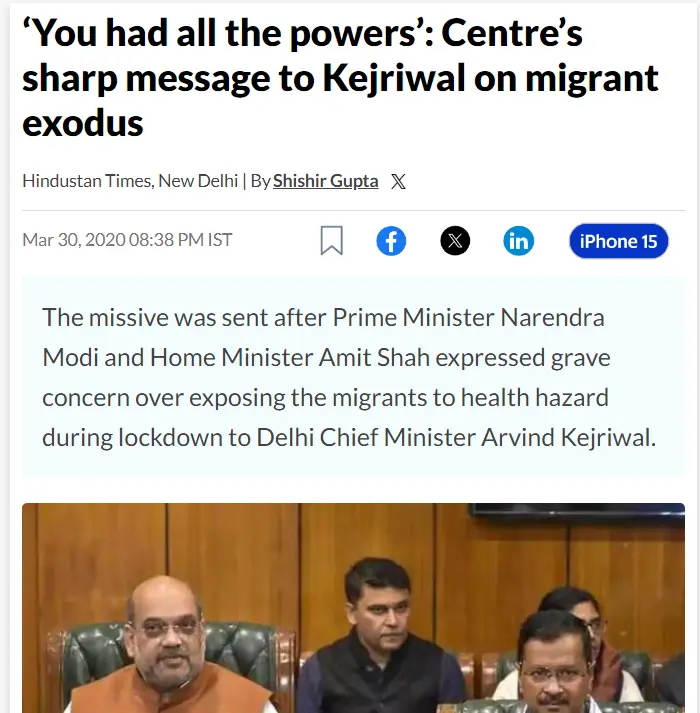
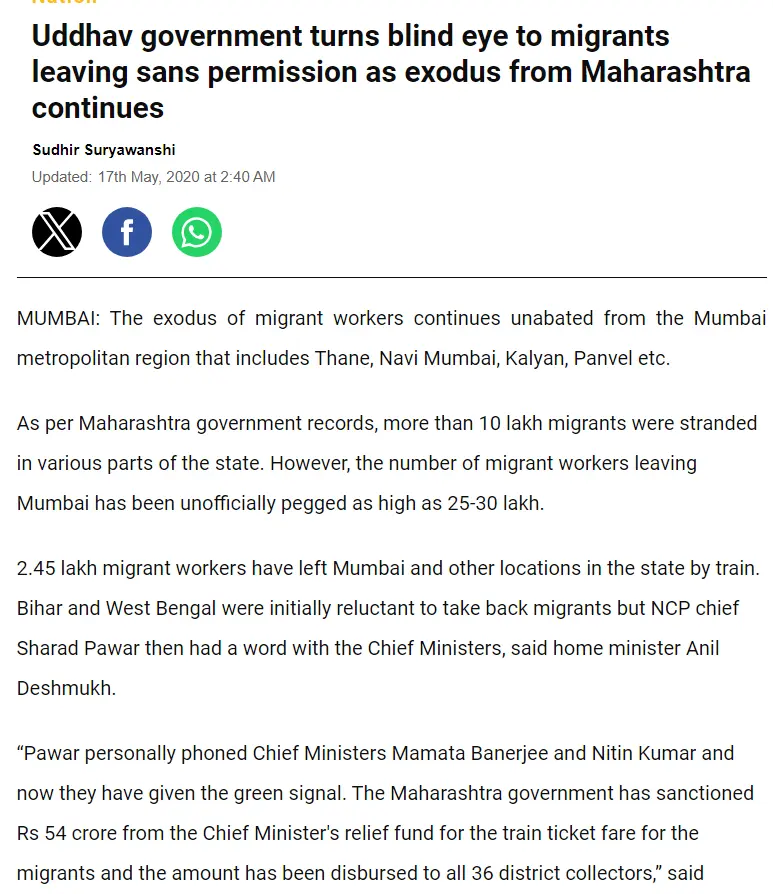
Both leaders, serving as Chief Ministers of two of India’s top employment-generating states – Delhi and Maharashtra (home to Mumbai) – faced criticism for their handling of the migrant worker crisis during the pandemic. As the virus struck, hundreds of thousands of migrant workers fled the metropolitan cities, exacerbating disruptions in the labor market. Despite repeated pleas from the central government to retain these workers, assuring provision of food and shelter, Kejriwal and Thackeray’s actions instilled fear among migrants, triggering mass migration.

Kejriwal, in particular, faced scrutiny for deporting migrant laborers to Delhi bus stations using government buses, facilitating their return to their villages. Given the pivotal role of Delhi and Mumbai in job creation across formal and informal sectors, the actions of these two chief ministers severely impacted India’s economic prospects. In essence, the mismanagement of the migrant crisis by Kejriwal and Thackeray, coupled with the broader challenges posed by the pandemic, shook the job market in India.

4. Unemployment Trends: Reflecting on UPA and Modi Era
While it’s common for the opposition to criticize the ruling government, it’s equally important for the Congress party and its UPA coalition to reflect on their own track record. Analyzing the unemployment rates during the UPA’s 10-year tenure reveals noteworthy fluctuations and trends. According to data from the World Bank, the unemployment rate from 2004 to 2013 was as follows: 8.53% in 2004, 8.70% in 2005, 8.63% in 2006, 8.54% in 2007, 8.35% in 2008, 8.38% in 2009, 8.32% in 2010, 8.17% in 2011, 8.10% in 2012, and 8.04% in 2013.
However, once the Modi government assumed office, there was a noticeable shift in the employment scenario, with the unemployment rate dropping below 8 percent. From 2014 to 2021, the unemployment rate, according to World Bank data, was 7.98% in 2014, 7.92% in 2015, 7.84% in 2016, 7.73% in 2017, 7.65% in 2018, 6.51% in 2019, 10.20% in 2020, and 7.71% in 2021. Additionally, according to CMIE data, from 2008 to 2023, the unemployment rate fluctuated as follows: 5.41% in 2008, 5.54% in 2009, 5.55% in 2010, 5.43% in 2011, 5.41% in 2012, 5.42% in 2013, 5.44% in 2014, 5.44% in 2015, 5.42% in 2016, 5.36% in 2017, 5.33% in 2018, 5.27% in 2019, 3.21% in 2023, and 6.57% in 2024 (as of January).
Comparing the World Bank and CMIE data, it’s evident that a trend emerged after the Modi government assumed power, reversing the economic trajectory set in motion by the Manmohan Singh government, which was marred by corruption scandals and relatively low GDP growth rates of 5.46% in 2012 and 6.39% in 2013. It’s worth noting that before the pandemic struck, the unemployment rate had decreased to 6.51% (World Bank) and 5.27% (CMIE). However, the employment landscape changed dramatically after the onset of COVID-19. Nevertheless, one can imagine a scenario where leaders like Arvind Kejriwal and Uddhav Thackeray could have mitigated labor exodus, potentially leading to a more favorable employment scenario.
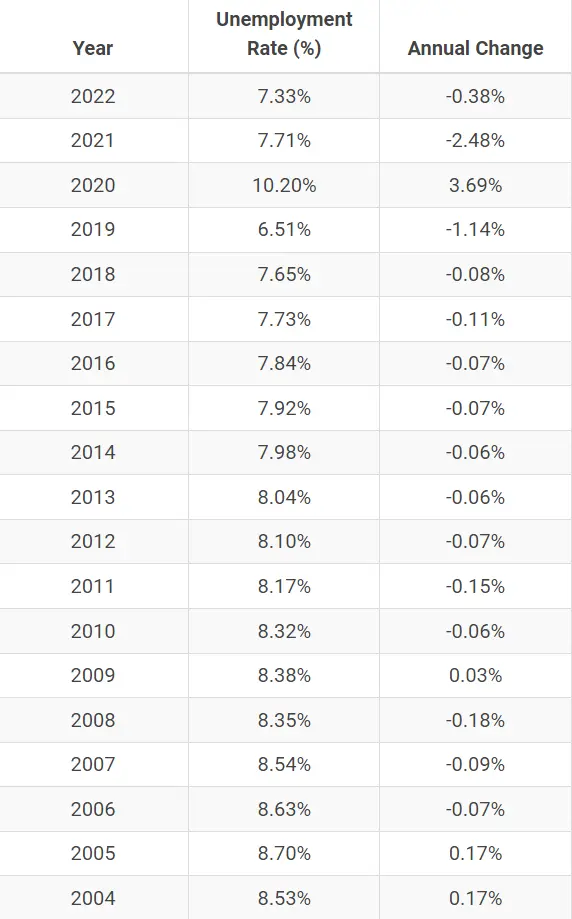
5- India’s Job Market- A Complex Conundrum
Before the advent of the Narendra Modi government, India’s job landscape was predominantly divided into two sectors: formal and informal. However, with the implementation of schemes like the Startup India initiative and a concerted effort to improve the ease of doing business, the Modi administration ushered in a dynamic era of business and job opportunities in the country.
In India, the informal sector employs around 80% of the labor force, while the formal sector employs the remaining 20%. The informal sector contributes about half of the country’s GDP.
A report by The Indian Express in March 2024 highlighted a significant improvement in the ’employment condition index’ between 2004-05 and 2021-22. This index, based on seven labour market outcome indicators, revealed a rise in informal employment, with nearly 82% of the workforce engaged in the informal sector. Self-employment emerged as the primary source of employment, accounting for 55.8% of the workforce in 2022.
Moreover, according to a report by the Economic Times in September 2023, India witnessed the creation of 52 million formal jobs over the past four years. This growth was fueled by initiatives such as the 59-minute loan approval scheme for MSMEs, which sanctioned 5,314 loans in the current financial year as of March 1, 2023. Furthermore, by February 2024, the Pradhan Mantri Mudra Yojana (PMMY) has approved 43 crore loans amounting to ₹22.5 lakh crore, out of which 30 crore loans have been extended to women entrepreneurs. This accounts for approximately 70% of the overall loans disbursed.

Since the inception of the Startup India initiative in 2016, the Department for Promotion of Industry and Internal Trade (DPIIT) has recognized a staggering 92,683 entities as startups as of February 28, 2023. This recognition is based on the eligibility criteria outlined in G.S.R. notification 127 (E) dated February 19, 2019. The number of entities recognized as startups by DPIIT has shown a steady increase over the years, with 8,635 in 2018, 11,279 in 2019, 14,498 in 2020, 20,046 in 2021, and 26,542 in 2022.
Additionally, the real estate sector witnessed a notable surge in employment, with the employment rate rising from 4 crore to 7.1 crore between 2013 and 2023, as reported by News18. Policy reforms under the Modi government contributed to this growth, with the sector now accounting for over 18% of the total workforce in India.

Furthermore, India’s burgeoning unicorn ecosystem, as reported by Business Today, showcased the country’s prowess in job creation, with 67 unicorns valued at over a billion dollars each. This surge in unicorns underscores the robust growth trajectory of the Indian economy, bolstered by the unwavering support of the government.
In essence, the employment figures and the substantial loan amounts sanctioned under various schemes reflect the remarkable economic growth witnessed in India, propelled by government initiatives and conducive policy reforms.
6- Global Challenges: Conflicts, AI, and Economic Uncertainties Impact Job Markets Worldwide
In today’s globalized economy, the interconnectedness of nations means that events in one part of the world can reverberate across the globe. Over the past four years, amidst the COVID-19 pandemic and conflicts such as the Russia-Ukraine war and the Israel-Hamas-Palestine conflict, the global supply chain has been disrupted, impacting markets and employment rates.
According to recent data from October 2023, European countries exhibit varying unemployment rates, with Germany at 3%, France at 7%, Italy at 7.8%, the UK at 4.2%, Spain at 12.0%, Greece at 9.6%, Finland and Sweden at 7.8 and 8.5, respectively. While developed nations like the United States, Australia, Canada, and Japan have largely recovered from pandemic and war-related economic challenges, emerging and developing economies continue to face difficulties.
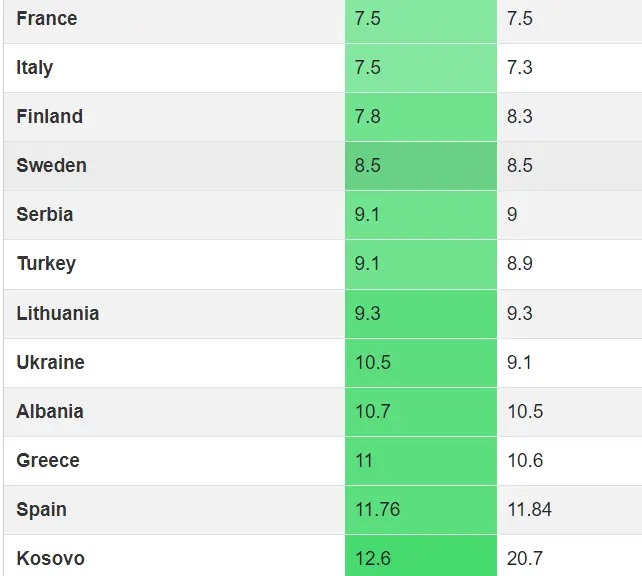
Reports indicate that conflicts such as the Israel-Hamas-Palestine war have had ripple effects on India’s labor market. The threat of a global recession, compounded by the Russia-Ukraine conflict, has also contributed to a decline in foreign direct investment (FDI) in India, falling by 22% to USD 46 billion in 2022-23.
Additionally, the rise of Artificial Intelligence (AI) presents challenges to India’s job market. Studies suggest that AI could impact up to 30% of jobs in the country. Globally, an estimated 40% of jobs are vulnerable to AI influence, with varying degrees of risk across countries.
According to the International Labour Organization (ILO), while the global unemployment rate improved slightly to 5.1% in 2023, underlying fragilities persist. Projections indicate a worsening labor market outlook in 2024, with an additional two million workers expected to seek employment, raising the global unemployment rate to 5.2%. Disparities between higher and lower-income countries persist, with low-income nations bearing a greater burden.
Hence, a multitude of factors contribute to global unemployment rates, including geopolitical conflicts, technological advancements like AI, and economic uncertainties. While developed nations may have rebounded from pandemic and war-related challenges, many developing economies, including India, continue to grapple with the fallout.
7- Addressing India’s Unemployment Challenge: Shifting Mindsets and Embracing Change
India’s unemployment rate of 7.6 percent presents an opportunity for the nation’s youth to adopt a more dynamic approach towards employment. Criticizing the prevalent obsession with government jobs and the extensive pursuit of the UPSC examination, former Chief Economic Advisor and current Economic Advisory Council to the Prime Minister member Sanjeev Sanyal denounced the prolonged preparation for civil services examinations as a wasteful expenditure of youthful energy. Sanyal emphasized that such examinations should only be pursued by those aspiring to become administrators, cautioning against the detrimental effects of spending years solely focused on exam preparation.
Similarly Chief Economic Advisor Nageswaran emphasized the limitations of government intervention in solving unemployment issues. Speaking at the launch of the ‘India Employment Report 2024’, Nageswaran stressed the importance of broader discussions involving the commercial sector, industrial units, industry associations, and academia to address economic challenges.
Therefore the discourse surrounding India’s unemployment challenge underscores the need for a paradigm shift in the approach to employment. While government initiatives play a crucial role, Chief Economic Advisor Nageswaran and former CEA Sanjeev Sanyal highlight the importance of broader stakeholder engagement and a shift away from traditional career paths. As India’s youth navigate the complex job market, it becomes imperative to channel their energies towards avenues that offer greater opportunities for growth and fulfillment. By embracing innovation and diversifying career pursuits, the nation can unlock its true potential and chart a path towards sustainable economic progress.
8- India’s Employment Landscape: Diverse Sectors Poised for Growth, Government Initiatives Drive Job Creation
According to the Observer Research Foundation (ORF) report India’s employment trajectory is undergoing a profound shift, marked by a diverse array of sectors primed for significant growth. The nation’s expansive and varied economy has witnessed notable changes in its employment landscape over time. As India advances along its economic journey, several key sectors are poised to shape the country’s employment prospects in the years to come.
Digital Services: India’s leadership in the Fourth Industrial Revolution has spurred innovation and the widespread adoption of digital technologies across sectors, driving demand for skilled professionals in areas such as software engineering, data science, and digital marketing. Projections indicate that the digital economy could generate between 60 to 65 million jobs by 2025, emphasizing the crucial role of digital skills in the future workforce.

Financial Services: The financial sector is undergoing rapid expansion, fueled by growing demand for banking and insurance services, alongside advancements in fintech. This transformation presents opportunities in digital banking, cybersecurity, and insurance technology, with significant growth potential expected in the coming years.
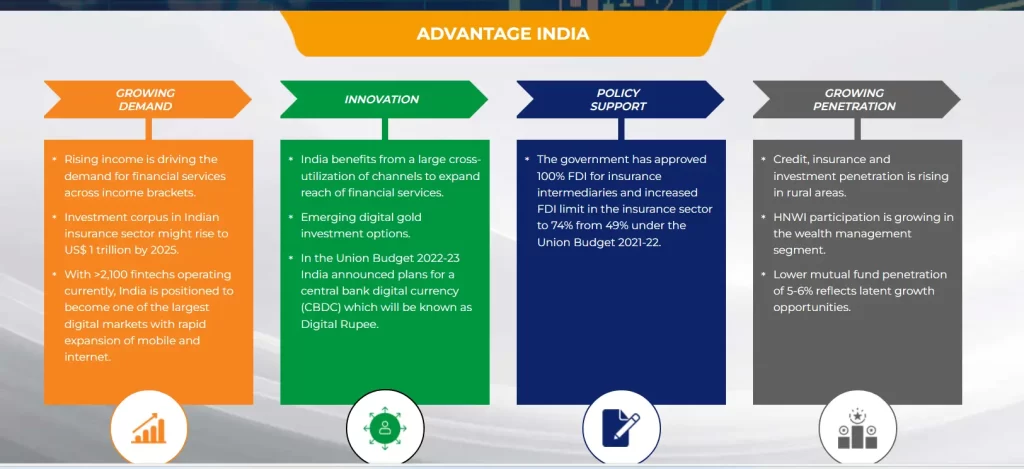
Health Services: India’s healthcare sector is experiencing notable growth due to factors such as an aging population and increased healthcare awareness. Technological innovations like telemedicine have further enhanced accessibility to medical services, contributing to the sector’s expansion.
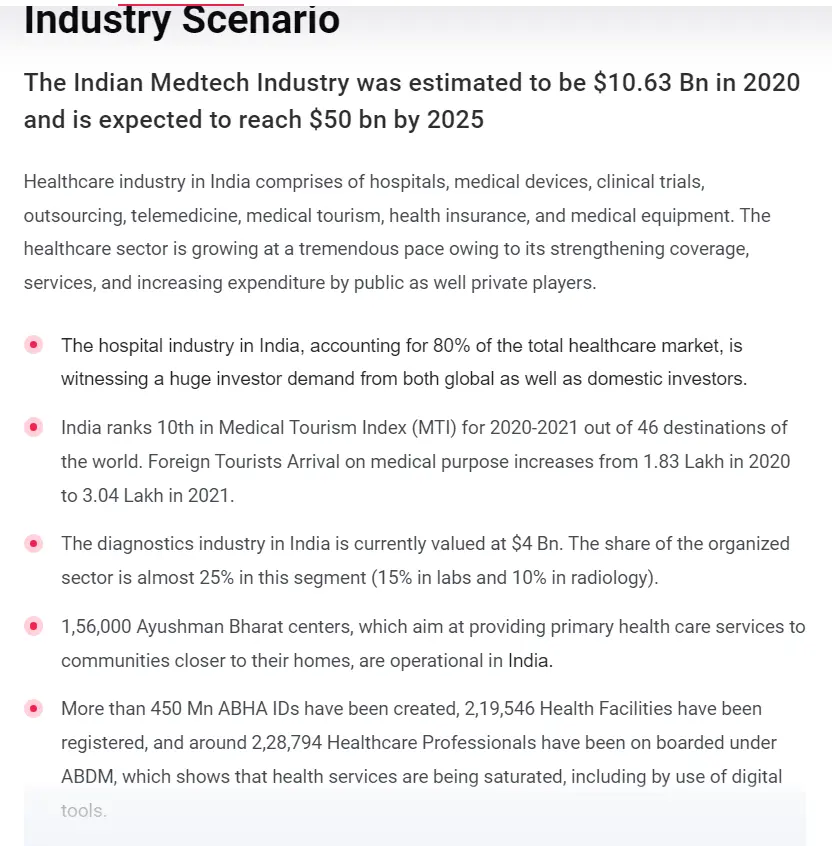
Hospitality Services: The tourism industry is poised for growth, offering employment prospects in various areas such as hotel management, transportation, and entertainment. Post-pandemic recovery efforts are expected to stimulate economic development and job creation within the hospitality sector.
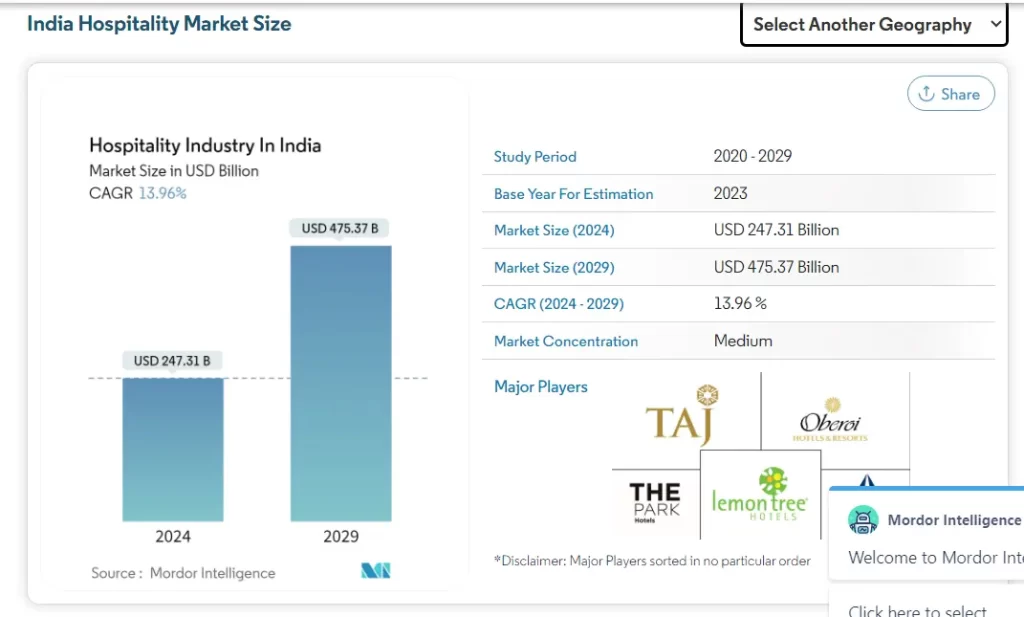

Consumer Retail Services: The retail landscape is undergoing a transformation with the rise of e-commerce, creating opportunities in areas like logistics, digital marketing, and warehousing. Projections indicate substantial growth potential, driven by India’s expanding middle-class population.
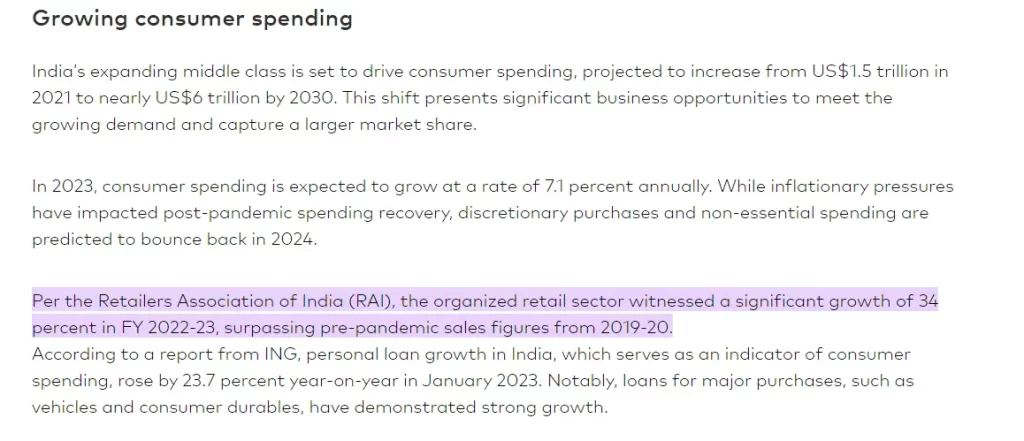
Global Capability Centers (GCCs): GCCs play a vital role in supporting multinational companies’ operations, offering diverse job opportunities in areas such as customer support, IT consulting, and finance.
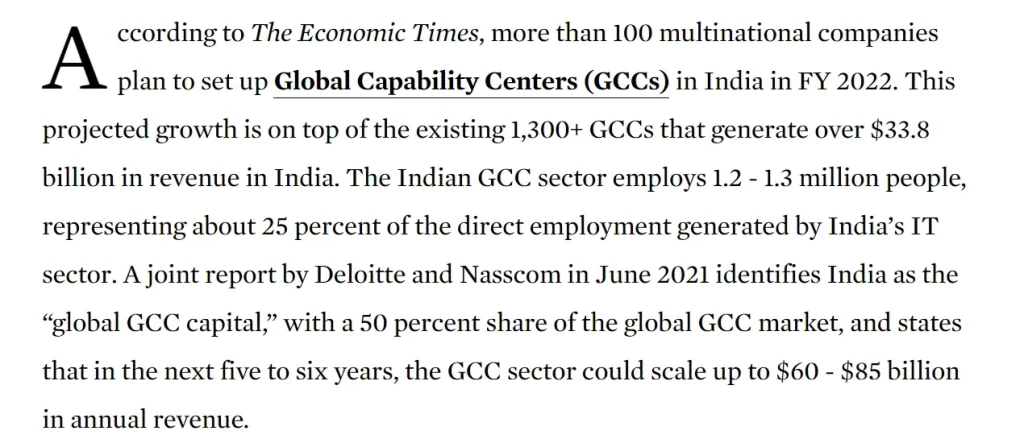
Renewable Energy: India’s focus on clean energy solutions presents opportunities in sectors like solar and wind power, with potential job creation in installation, maintenance, and research within the renewable energy field.
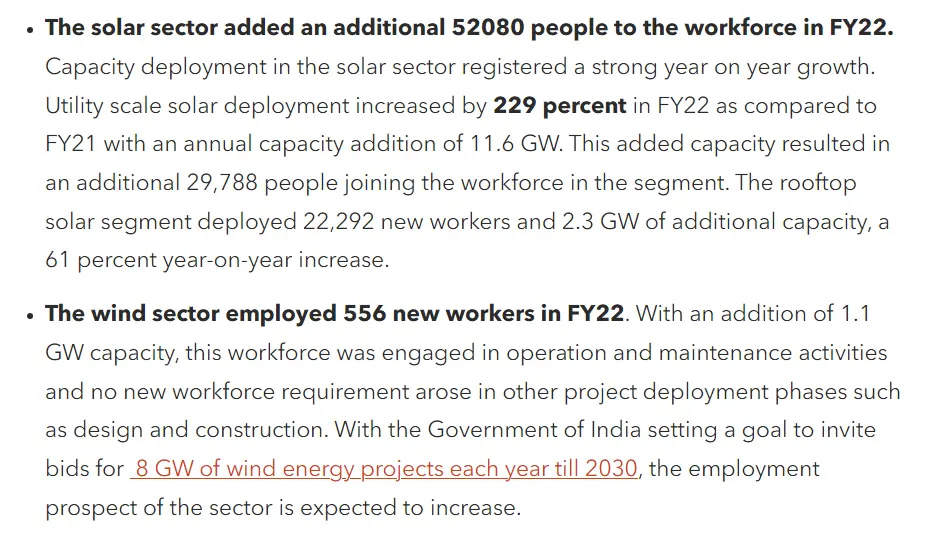
E-commerce: The growth of online shopping has led to increased demand for logistics and delivery services, creating jobs in areas like digital payment processing and merchandising.
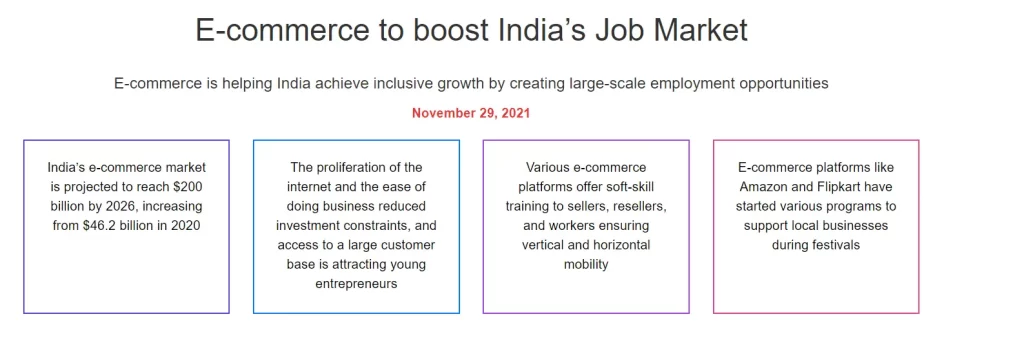
MSMEs (Micro, Small, and Medium Enterprises): MSMEs are integral to India’s economy, contributing significantly to GDP and employment. They serve as hubs for entrepreneurship and innovation, supporting livelihoods across the country.

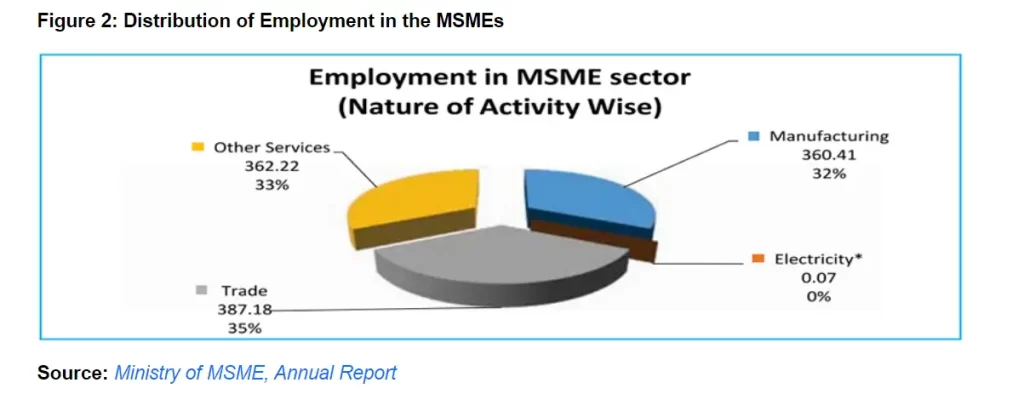
Startup Ecosystem: India’s startup ecosystem, buoyed by government policies and tax incentives, has emerged as a hotbed of innovation and job creation. The country’s efforts to foster entrepreneurship have enhanced its global competitiveness and contributed to job growth in cities like Bengaluru, Mumbai, and Chennai.
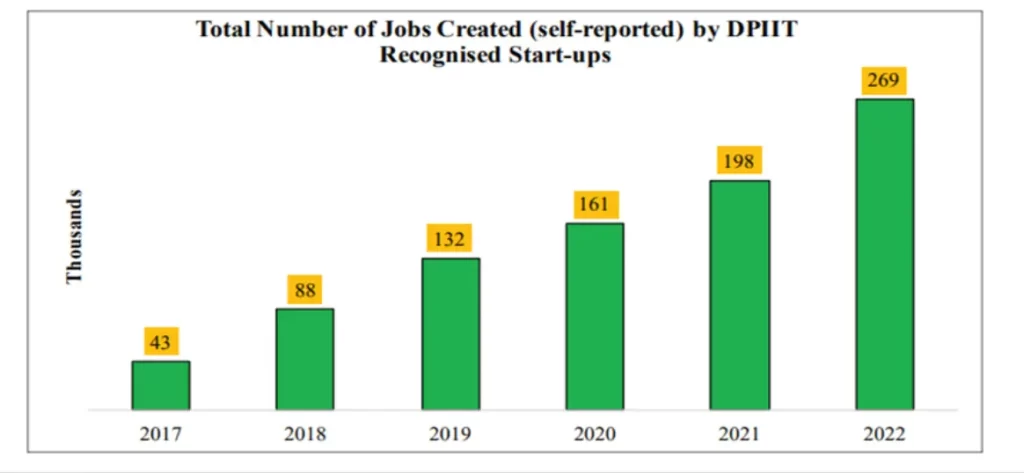
In summary, India’s current unemployment rate is expected to decline significantly based on emerging trends. Government initiatives across diverse sectors, coupled with enhanced geopolitical influence, are projected to attract foreign direct investment, both in green and traditional industries. Furthermore, with over 65% of the population under the age of 35, India presents an appealing opportunity for industries and job creation. However, the youth must prepare themselves for upcoming job opportunities. With proactive government measures and a dynamic workforce, India is well-positioned for diverse and robust employment expansion as it pursues its goal of becoming the world’s third-largest economy by 2027-28.

